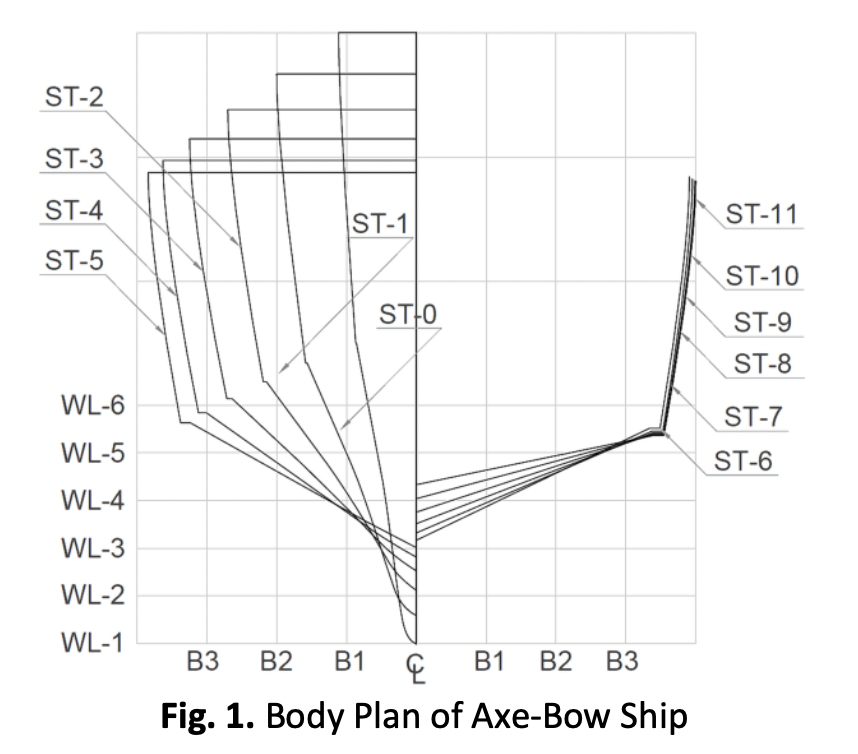Computational Investigation into Predicting Total Resistance of Axe-Bow Ship’s in Calm Water
DOI:
https://doi.org/10.37934/cfdl.15.11.115Keywords:
Axe-bow, total resistance, pressure resistance, viscous resistance, CFDAbstract
The axe-bow ship design has been primarily introduced to minimize ship's slamming condition during sailing, which inherently deals with sufficient of her total ship's resistance. The presence of nonlinear-hydrodynamic flow behaviours around the ship will forcefully impose pressure and viscous resistances on her hull. This complex phenomenon is so intricate that a reliable approach leading into more feasible prediction of her total ship’s resistance (RT) is necessarily required, while explaining the rationale behind the analysis results. This paper presents a computational investigation into prediction total ship's resistance of an axe-bow hull in the calm water condition. Here, the Computational Fluid Dynamic (CFD) software called Numeca Fine Marine was accordingly used. Several parameters such as various Froude numbers (Fr) and trim's angles, have been taken into account in the computational simulations. The results showed that the viscous ship’s resistance has more relatively significant influence on the axe-bow ship than the pressure ship’s resistance especially at Fr ≥ 0.568. It is noteworthy that this causes the pressure resistance coefficient (CP) decrease indicated with moderately diminished high-pressures acting on the axe-bow ship’s hull. The increase of the trim’s angle demonstrates that the existence of the higher turbulent viscosity extends over the entire submerged hull surfaces and causes reduction of the viscous coefficient (CV). In general, the subsequent increase of Froude number and the trim’s angle were proportionally to the total ship’s resistance. It can be concluded that the current computational results are useful as preliminary prediction of the total ship’s resistance towards determining the effective power.
Downloads
References
Hadi, E. S., and A. Firdhaus. "Total resistance analysis on bow form model ulstein X-bow with various angle of flare and stem angle." In IOP Conference Series: Materials Science and Engineering, vol. 674, no. 1, p. 012003. IOP Publishing, 2019. https://doi.org/10.1088/1757-899X/674/1/012003
Mosaad, Mohamed A., M. M. Gafaary, Waleed Yehia, and Hussien Mohamed Hassan. "On the Design of Axe-bow for Ship Energy Efficiency." In Influence of EEDI on Ship Design & Operation, pp. 1-7. 2017.
Basil, Kunjachan T., and Najdan Waris C. P. "Hull Optimisation of Fishing Trawlers Using Ulstein Axe-Bow And Bilge Keel." International Journal of Engineering Applied Sciences and Technology 7, no. 2 (2022): 214-220. https://doi.org/10.33564/IJEAST.2022.v07i02.032
Simanjuntak, Frans, Samuel Samuel, Parlindungan Manik, Eko Sasmito Hadi, and Willma Amiruddin. "Analisis Pengaruh Pengunaan Ulstein X-Bow pada Kapal Perintis Type 750 DWT Terhadap Nilai Hambatan dengan Metode Computational Fluid Dynamics." Rekayasa Hijau: Jurnal Teknologi Ramah Lingkungan 5, no. 3 (2021): 248-266. https://doi.org/10.26760/jrh.v5i3.248-266
Chen, Shuling, Beilei Zou, Changzhi Han, and Shiqiang Yan. "Comparative Study on Added Resistance and Seakeeping Performance of X-Bow and Wave-Piercing Monohull in Regular Head Waves." Journal of Marine Science and Engineering 10, no. 6 (2022): 813. https://doi.org/10.3390/jmse10060813
Fitriadhy, A., and N. Amira Adam. "Heave and pitch motions performance of a monotricat ship in head-seas." International Journal of Automotive and Mechanical Engineering 14, no. 2 (2017): 4243-4258. https://doi.org/10.15282/ijame.14.2.2017.10.0339
Zikry, Syafiq, and Ahmad Fitriadhy. "Seakeeping performance of a hydrofoil in waves using cfd approach." Universiti Malaysia Terengganu Journal of Undergraduate Research 3, no. 3 (2021): 167-176. https://doi.org/10.46754/umtjur.2021.07.017
Rahman, Mustafizur, M. A. Alim, Suman Saha, and M. K. Chowdhury. "Mixed convection in a vented square cavity with a heat conducting horizontal solid circular cylinder." Journal of Naval Architecture and Marine Engineering 5, no. 2 (2008): 37-46. https://doi.org/10.3329/jname.v5i2.2504
Fitriadhy, Ahmad, Nur Adlina Aldin, and Nurul Aqilah Mansor. "CFD analysis on course stability of a towed ship incorporated with symmetrical bridle towline." CFD Letters 11, no. 12 (2019): 88-98.
Fitriadhy, Ahmad, and Amira Adam. "CFD analysis on vertical motion of a full-scale floating jetty." Journal of Sustainability Science and Management 15, no. 6 (2020): 100-110. https://doi.org/10.46754/jssm.2020.08.009
Fitriadhy, Ahmad, Nur Amira Adam, C. J. Quah, Jaswar Koto, and Faisal Mahmuddin. "CFD prediction of b-series propeller performance in open water." CFD Letters 12, no. 2 (2020): 58-68.
Fitriadhy, Ahmad, Intan Nur Nabila, Christina Bangi Grosnin, Faisal Mahmuddin, and Suandar Baso. "Computational Investigation into Prediction of Lift Force and Resistance of a Hydrofoil Ship." CFD Letters 14, no. 4 (2022): 51-66. https://doi.org/10.37934/cfdl.14.4.5166
Fitriadhy, Ahmad, Loke Yan Pheng, Iqmal Nor Hakim Adzkh, Faisal Mahmuddin, Anuar Abu Bakar, Mohd Azlan Musa, and Mohd Sofiyan Sulaiman. "Computational Investigation of Pitch Motion of a High-Speed Craft Incorporated with Trim-Tabs." CFD Letters 14, no. 6 (2022): 56-71. https://doi.org/10.37934/cfdl.14.6.5671
Mirzaei, Mahdi, A. Maimun, A. Priyanto, and A. Fitriadhy. "Mooring pattern optimization using a genetic algorithm." Jurnal Teknologi 66, no. 2 (2014): 189-193. https://doi.org/10.11113/jt.v66.2519
Menter, Florian, and Christopher Rumsey. "Assessment of two-equation turbulence models for transonic flows." In Fluid Dynamics Conference, p. 2343. 1994. https://doi.org/10.2514/6.1994-2343
Spalart, Philippe, and Steven Allmaras. "A one-equation turbulence model for aerodynamic flows." In 30th Aerospace Sciences Meeting and Exhibit, p. 439. 1992. https://doi.org/10.2514/6.1992-439
Molland, A. "Resistance experiments on a systematic series of high speed catamaran forms: Variation of length-displacement ratio and breadth-draught ratio." Transactions of the Royal Institution of Naval Architects 138 (1996): 59-71.




























